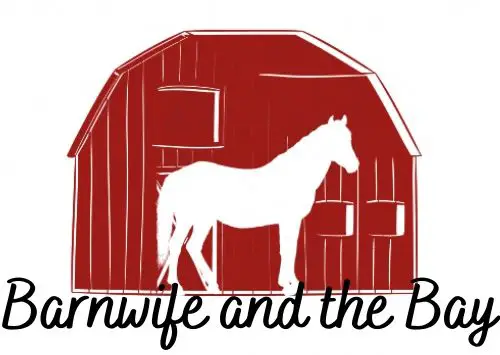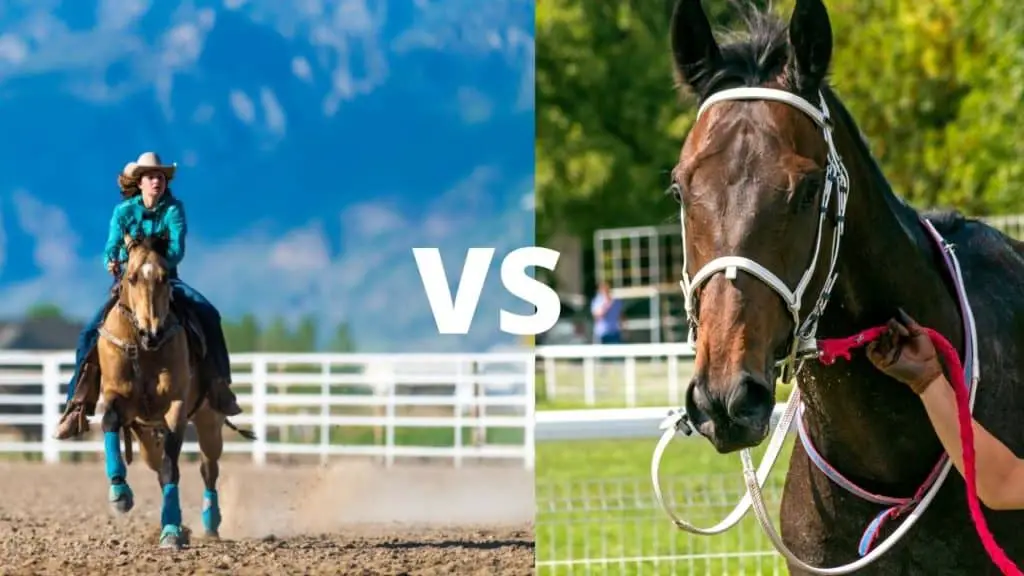
American Quarter Horses and Thoroughbreds are two of the most popular breeds of horses in North America. They are common in the rest of the world as well. Here are the biggest differences between these two kinds of horses originally bred for racing.
Physical characteristics
Quarter Horses and Thoroughbreds differ in many aspects of their body types as a result of their different lineages.
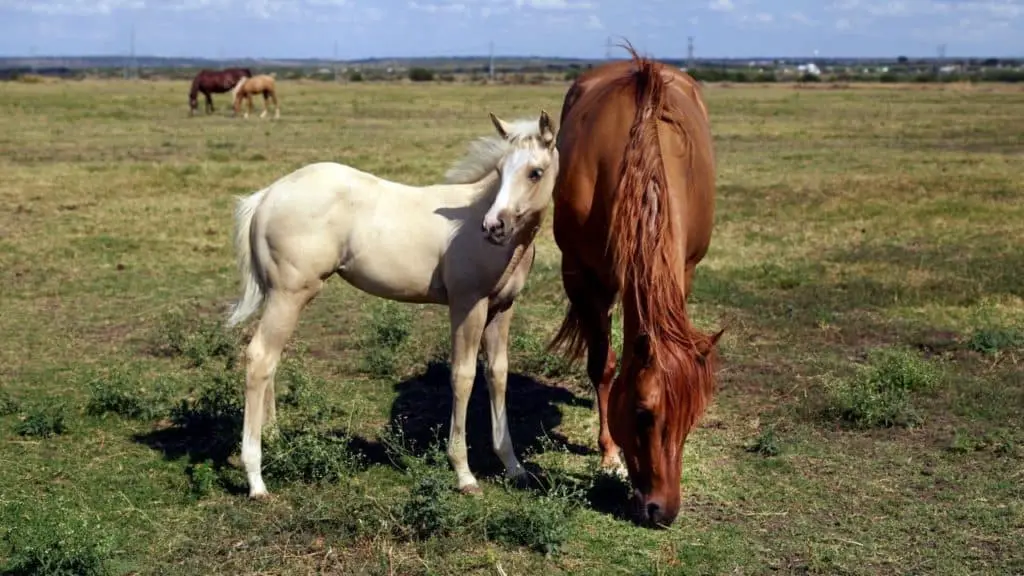
Quarter Horses are relatively small and stocky
Quarter Horses physical characteristics
Typical characteristics of Quarter Horses are:
- Average height of 15hh
- Short head and relatively short neck
- Short back
- Broad chest
- Broad, round hindquarters
- Muscular body

Thoroughbreds have a long and lean body type
Thoroughbred Horses physical characteristics
Typical characteristics of Thoroughbred Horses are:
- Medium height, averaging 16.1hh
- Long neck
- Lean body
- High withers
- Deep chest, but narrow
- Long legs
Breed origins
Quarter Horses are an American breed, while Thoroughbreds are an English breed. However, there are some similarities between the two breeds’ ancestry.
Quarter Horse breed origin
The American Quarter Horse breed began in the mid-seventeenth century. English colonists in Virginia crossed their horses (of Spanish descent) with English horses they imported. By the late seventeenth century, the new breed was racing in short distance races, usually a quarter mile. So they received the name Quarter Horses.
The breed continued to grow, and in 1940 the American Quarter Horse Association (AQHA) was established as the breed registry for Quarter Horses. The AQHA is now the largest breed registry in the world; a testament to the enthusiasm of horse owners for these versatile horses.
Quarter Horses now undergo a high degree of selective breeding for particular sports, like reining, western pleasure, or barrel racing. Many Quarter Horse lines have considerable Thoroughbred blood in their background, especially racing Quarter Horses. There’s even a special designation for the offspring of a registered Quarter Horse and registered Thoroughbred: an Appendix Quarter Horse.
Thoroughbred breed origin
The Thoroughbred breed originated in the late 1600s and early 1700s. During this time, 3 foundation stallions ( the Darley Arabian, the Godolphin Arabian and the Byerly Turk) were imported to England from the Middle East and bred with native English horses.
The English horses provided strength and the Arabian stallions contributed stamina and courage to the bloodlines. The result was a horse that could carry weight at speed over long distances, and changed the growing sport of horse racing.
In North America, Thoroughbreds are registered with the Jockey Club. Other parts of the world have their own registries for Thoroughbreds.
Thoroughbred and Quarter Horse racing
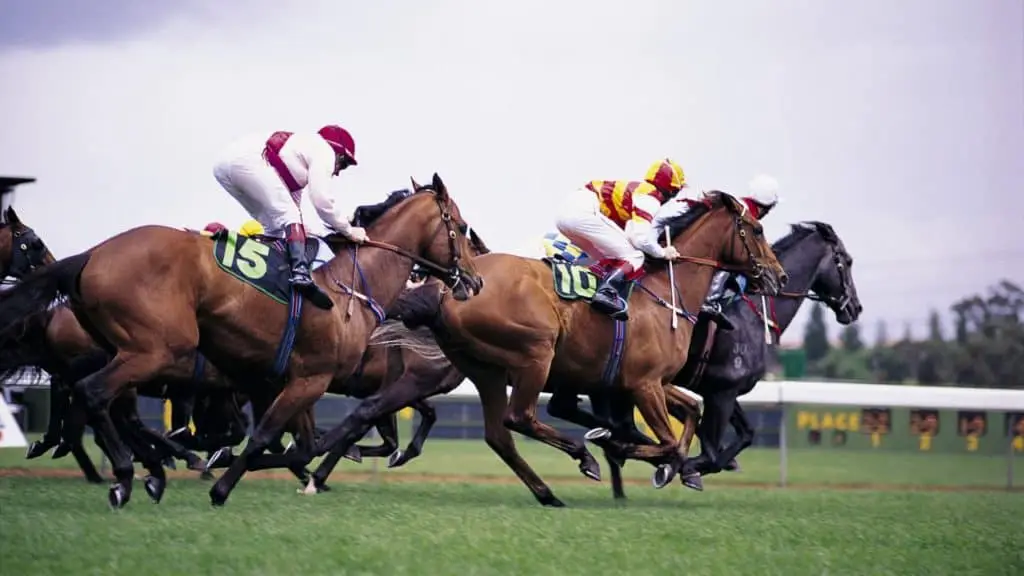
Thoroughbreds and Quarter Horses can both be racehorses
Thoroughbred racing originated in England, and came to the American colonies as early as 1665. Today the volume of racing in the United States outweighs that of any other country.
Quarter Horse races typically take place over short distances, on the straight part of the oval race track. Most often the distances are between 220 yards and 550 yards. The classic Quarter Horse distance is a quarter of a mile, 440 yards.
A distance race for a Quarter Horse is 870 yards, or a half mile. This is in contrast to Thoroughbred races, which take place over a longer distance: typically 1 mile and 3 sixteenths to one mile and a half.
The majority of Quarter Horse racing takes place in the United States. For Thoroughbreds, many prestigious races take place in Great Britain.
Thoroughbreds and Quarter Horses in other sports
Broadly speaking, Quarter Horses are usually western horses and Thoroughbreds are usually English style horses.
Quarter Horses are suited to sports that combine speed with exceptional stopping and turning ability. A few show disciplines they excel at are rodeo events, reining, and cow work.
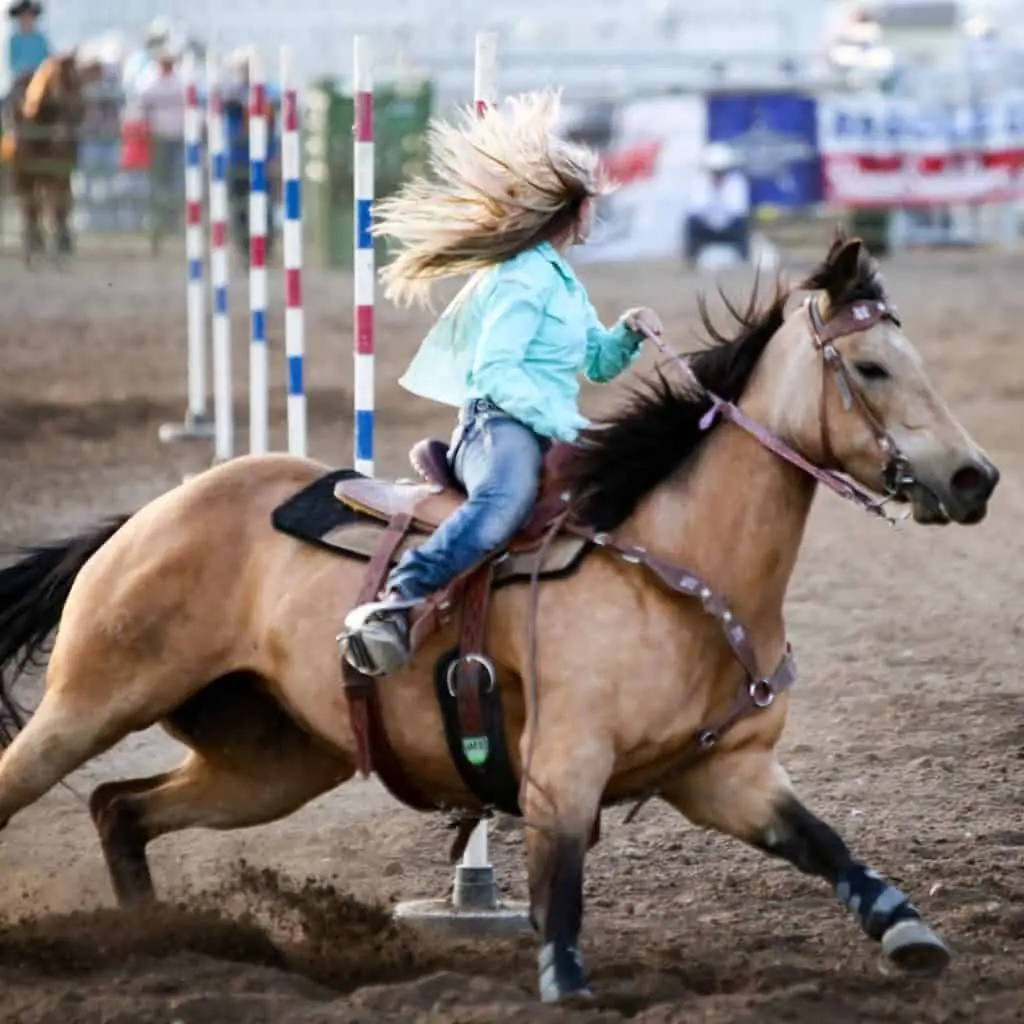
A Quarter Horse and rider compete in pole bending.
Quarter Horses are also used as working ranch horses on cattle ranches. They are often bred to have exceptional cow sense, which makes them good for this work and showing in events like cutting and team penning.

A Thoroughbred and rider compete in the cross country phase of a 3-day event.
Thoroughbreds excel at sports that require speed and courage, like jumping and 3-day eventing. Thoroughbreds also do well at the lower levels of dressage, where the stockier, more muscular bodies of Quarter Horses can hold them back.
Thoroughbred vs Quarter Horse temperament
In general, Thoroughbreds can be a little more high-strung, sensitive, and nervous than Quarter Horses. Quarter Horses are often a little more laid-back. However, within the two breeds there is a great amount of variation in personality and temperament between individuals.
In my experience with the two breeds, the Quarter Horse had a good temperament for me as a beginner, and the Thoroughbred is a little more challenging. Not that The Bay is a difficult horse by any means, she is just more sensitive and gets stressed more easily than my unflappable Quarter Horse Paint.
Health problems
Besides the health hazards inherent to all horses, some health issues are a little more common in certain breeds.
Quarter Horse health problems
In Quarter Horses, the main health problems to look out for are genetic diseases. These include Polysaccharide Storage Myopathy (PSSM), Hyperkalemic Periodic Paralysis (HYPP), and Hereditary Equine Regional Dermal Asthenia (HERDA). Some genetic diseases are so common in Quarter Horses that they must be tested for in order to register a horse with AQHA.
Polysaccharide Storage Myopathy (PSSM). PSSM is a glycogen storage disease that affects how the muscles work. It was first identified in Quarter Horses but can affect other breeds as well. It is estimated that in the general Quarter Horse population, 6-10% are affected with the disease.
Hyperkalemic Periodic Paralysis (HYPP). HYPP is a genetic disease of the muscles that results in sporadic muscle tremors or paralysis. About 4.4% of Quarter Horses are affected. It’s especially likely if the individual can trace their lineage to a stallion named Impressive.
Hereditary Equine Regional Dermal Asthenia (HERDA). HERDA is a genetic skin condition usually seen in Quarter Horses. Signs include overly stretchy skin,scarring and wounds across the back. About 2.5-3.8% of Quarter Horses carry the gene for this condition, many of whom are cutting horses.
Thoroughbred health problems
Thoroughbreds often have health issues related to their breeding as race horses. They suffer problems common to actively racing horses of any breed. These include fractures, and bleeding from the lungs. Off the track, the main issues to look out for in Thoroughbreds are stomach ulcers and poor hoof quality.
Stomach ulcers. Stomach ulcers are painful sores in the lining of the stomach. Ulcers are extremely common in Thoroughbreds coming off the race track. They also commonly occur in other performance horses, but estimates of prevalence in racehorses range from 50%-90%.
Poor hoof quality. Many Thoroughbreds struggle with thin soles and hoof walls, and flat feet. These problems can cause foot soreness. Occasionally Thoroughbreds also have feet that are too small relative to their body mass.
Price
As with any breed, the price of an individual Thoroughbred or Quarter Horse will depend on that individual’s lineage, training, and performance history. A foal or rescue horse could cost as little as $500-$1,000. However, an elite performance horse in any discipline could cost $50,000-$100,000 or more.
Thoroughbred racehorse price
To buy a two-year-old Thoroughbred in training for racing may cost you anywhere between $75,000 (occasionally less) and more than $10million (occasionally much more). These prices depend on the pedigree of the horse and how promising its racing career looks.
However, you can become part of a syndicate and own a piece of a racehorse for as little as $100.
Off the track Thoroughbred price
If you are looking for an equine partner to compete in jumping, eventing, or dressage, Thoroughbreds who are retired from racing can be adopted “off the track” for $1,500-$3,000. This is a great option if you are willing to put some time and effort into re-training the horse for your particular sport.
Many “off the track” Thoroughbreds have already begun their re-training and shown promise for different sports before they are offered for adoption. The more training they have off the track, the higher the sale price or adoption fee will be.
Racing Quarter Horse price
Buying a racing Quarter Horse can be significantly cheaper than buying a racing Thoroughbred. Many young Quarter Horses suited for racing are priced between $5,000 and $90,000.
The cost of owning a racehorse is more than just the purchase price. You also need to stable the horse, a trainer to train it, and jockeys to ride it. If you are part of a syndicate, the leaders of the syndicate usually take care of this part, as well as making racing decisions.
Conclusion
Both Thoroughbreds and American Quarter Horses have unique gifts to offer as racehorses, show horses, and pleasure riding partners. Their differences make them perfectly suited to excel in their particular niches, but both breeds often cross over to excel in unexpected areas.
Like this article about horse breeds? Race over to these too:
